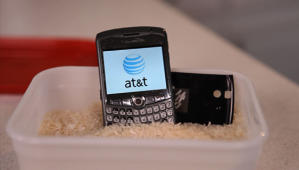High Gain Microphone Pre Amplifier
Posted On Saturday, April 28, 2012 at at 3:06 PM by OwnerThe best and cheap Pre-Amp circuit to make Microphone more sensitive to pick voice, although I had made one already but thought it worth try as it has nice gain around 100 as the author stated with a new chip TL071 which is low voltage high gain amplifier IC.
A little modification I made as you see some extra components are basically power supply using regulator chip LM7809 as I need it to run with 12V DC. This stand alone 9V regulator can be found here...
Schematics:
Finished Circuit :
Wet Cell Phone Rescue
Posted On Tuesday, June 14, 2011 at at 11:42 AM by OwnerDid you just drop your cellphone in water? Or maybe you'd like to know what to do if that happens! This week on Upgrade Your Life, Yahoo! News' Becky Worley shows us first aid techniques for rescuing a drowned smartphone.
To test them out, Becky took a BlackBerry, a Droid, and an iPhone, and dropped all three into room temperature water for 60 seconds. Then she went through the following steps:
Step 1: Do NOT turn on the phone
Why do water and smartphones not mix? Because the water shorts out your smartphone's electrical circuits. So whatever you do, don't turn it on to check to see if it still works.
Step 2: Pull out the battery and SIM card
You want to remove anything removable: Pull out the battery, the SIM card and the memory card, if your phone has one. As long as that battery's in there it's providing power to your phone, and that's what you need to stop immediately.
Some phones, like the iPhone, don't have a removable battery. Unfortunately, you'll just have to skip this step and hope for the best if you dunk one of them.
Step 3: Freshwater rinse
Did you drop your phone in salt water? The salt can corrode your device. So after you pull out the battery and SIM card, immerse your phone in fresh water to rinse out the salt.
Step 4: Dry your phone using compressed air
If you have a compressed air can handy -- the kind that's used to clean computers or keyboards -- run it full-blast all over your phone, with the back cover taken off if you can. A vacuum cleaner also works, even though it's pulling the air in the other direction. As long as it's blowing cool air over those circuits to dry them out, it's all good.
Don't stick your phone in the oven, even on low. The heat can warp your phone's circuits, and melt its internal components. You shouldn't use a blow dryer either, unless it has a heatless setting. A fan might help, but a microwave is out of the question.
Step 5: Cover your phone with uncooked rice
The premise of our experiment was to test if putting a wet phone into a sealed container of rice would actually dry it out, and bring it back form the dead. See, the idea behind the rice is that the dry grains will absorb moisture. So get a sealable plastic container, and fill it with enough rice to cover your smartphone. (A plastic zipper bag will work too, in a pinch.) Then bury your phone in the rice, along with its battery and other parts. You'll want to wait at least 24 hours for the rice to do its job -- Becky waited for 48 hours, in her test.
What would work better than rice? Silica gel, the stuff in those packets that keep new clothes or shoes dry. But most of us don't have a shoebox full of the stuff laying around, so rice will probably have to do. It may get pieces of rice into the crevices and cavities in your smartphone, but this is an emergency, and time is of the essence.
Should you use white or brown rice? It doesn't matter, so long as it's hard and dry and uncooked. You can even use rice from boxed meals like Rice-a-Roni. Just don't add in the seasoning packet, unless you want your phone to smell like mixed vegetables.
Step 6: Turn your phone back on
After you've waited at least 24 hours, it's time for the moment of truth. Reassemble your phone, charge it and try to power it on.
The results of our experiment weren't encouraging: the BlackBerry that Becky tested did restart, with no seeming long-term damage. But the iPhone and the Droid were dead. After two days in the rice and a full battery charge, neither phone came back to life.
One in three may be slim odds. But since water damage isn't covered by most warranties, it can't hurt to try.
Variable Power Supply 1.2 to 55 Volts 3 Ampere
Posted On Wednesday, June 23, 2010 at at 9:33 AM by Owner- Adjustable version output voltage range,
- 1.23V to 37V (57V for HV version) ±4% max over line and load conditions
- Guaranteed 3A output current
- Wide input voltage range, 40V up to 60V for
- HV version
- Requires only 4 external components
- 52 kHz fixed frequency internal oscillator
- TTL shutdown capability, low power standby mode
- High efficiency
- Uses readily available standard inductors
- Thermal shutdown and current limit protection
High Gain Mic Pre Amplifier
The best and cheap Pre-Amp circuit to make Microphone more sensitive to pick voice, although I had made one already but thought it worth try as it has nice gain around 100 as the author stated with a new chip TL071 which is low voltage high gain amplifier IC.
A little modification I made as you see some extra components are basically power supply using regulator chip LM7809 as I need it to run with 12V DC. This stand alone 9V regulator can be found here...
Schematics:
Finished Circuit :
5V 5A Higher currents by LM340-5 and 2N4398
Posted On Saturday, June 19, 2010 at at 12:28 PM by OwnerMic Preamp Filter
Posted On Saturday, June 12, 2010 at at 11:17 AM by Owner12v Fluorescent Inverter
Posted On Friday, June 11, 2010 at at 12:52 PM by OwnerA small and low cost fluorescent tube inverter circuit. Now forget you small emergency lights/LED lights.
1 – 2R2 1/4watt (for testing)
1 - 47R 1/4watt
1 - 180R 1watt
1 - 100ngreencap
1 - 100u 16v electrolytic
1 - TIP 3055 transistor
1 - on/off switch
1 - 12mm bolt and nut for transistor
1 - heat-sink 5cm x 10cm
1 - ferrite rod 10mm dia x 8m long
1 - 30m winding wire .28mm dia
1 - 4m winding wire .61 mm dia (wire diameters are NOT critical)
1 - insulation tape either sticky tape or masking tape
1 - interlayer insulation - paper
Notes:
It's very simple to build and requires no printed circuit board. The transformer is hand-wound on a ferrite rod (from an old transistor radio) and the winding wire can be salvaged from an old transformer.
The cost of powering the circuit is about 22 watts and this will produce the same light output as a 60 watt globe.
Caution:
While working with powered circuit pay extra attention to the transformer, during operations it produce lots of AC voltage around 1000 Volts. So DO NOT touch the winding going towards your tubes.
9 Volt 2 Amp Power Supply by 78S09
Posted On at at 12:29 PM by OwnerThis circuit can be make with out extra components but I added a diode IN5400 for reverse polarity protection, C1 provides extra smoothing and C2 for extra filering, if powering a logic circuit than a 100nF capacitor is also desirable to remove any high frequency switching noise.

![highgain preamp-TL071_thumb[1] highgain preamp-TL071_thumb[1]](https://blogger.googleusercontent.com/img/b/R29vZ2xl/AVvXsEhy_kehvMhGLu9_4zRG0rHqsXOZiy4JV8jZ3KmeHm1KCqHWSrj0V6deCzmXmAUMsywpxHG07x_nj1Buoz2GUCXK9WflfpY8hvpdno64D2dC0Rf0Qw6NQLOJ_rc9rnwuYecbP1RaZsCnqRw/?imgmax=800)
![MicPreamp-TL071-Circuit_thumb[1] MicPreamp-TL071-Circuit_thumb[1]](https://blogger.googleusercontent.com/img/b/R29vZ2xl/AVvXsEhuRyQOmUR39fteM4YfiljK1_8Z_Sw4VejPHhJejAnmwZSQqWeRCgQ5gcKvlij4Yc5_CfMfY7vVs4wVc648Cm5IQH16MpfbyQrqCnvASgCeeTULbs0EGDUpN2rL-3mLqGuOdMazqoK7PA8/?imgmax=800)









